On leaving Cleveland Museum of Art I continued my Churchill Fellowship, taking a later flight out of Ohio and landing at midnight in Rochester, New York to visit the Rochester Challenger Learning Centre and Bathysphere Underwater Biological Laboratory over a 2 day visit. Both sites are run by Monroe #1 BOCES, one of 37 cooperative educational services that support education in New York State (they even run their own radio station to teach broadcasting skills and a touring solar education classroom). In addition Monroe #1 BOCES run 10 video conferencing connections including underwater geometry via SCUBA, energy transformations and investigations of the ecology of Lake Ontario. As you could imagine, the skills of the team are diverse and so I was looking forward to checking out how they run classes that simulate being in a spaceship, a NASA command center or an underwater laboratory for a variety of student groups. They didn’t disappoint!
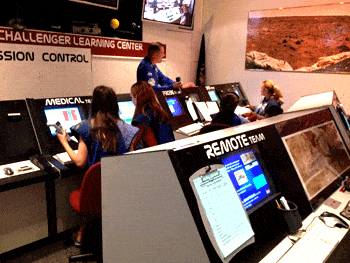
Challenger Learning Center, Rochester
First cab off the ranks was the Rochester Challenger Learning Center, one of 43 sites in the USA that run school education visits in honour of the Challenger Shuttle Mission STS-51L which sadly perished on January 28, 1986. Situated within the same building as the Strasenburgh Planetarium, the site is designed to emulate the challenges experienced by ground command staff and astronauts on a spaceship whilst completing a simulated mission to Mars. Schools can opt to first experience the Challenger Learning Center via video conference, whereby the mission commander briefs the students on what to expect when they arrive and the tasks and challenges that would be presented to them. Once onsite the kids are split into a ground team and space team are quickly ushered to their respective positions to fulfill the 2 hour mission that simulates landing a probe on Mars from a orbiting spacecraft.
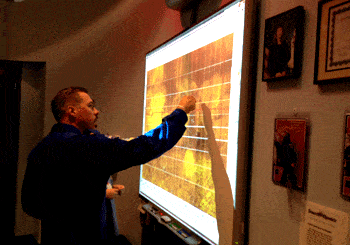
Plotting the Mars rover course coordinates
I’ve seen many science presentations over the years but this would have to rank as one of the best sessions I’ve seen in a long time. In the command center the kids worked in small teams including spaceship navigation, medical, remote robot guidance, data communication, life support systems, energy systems plus probe and communications between the ship and ground team. The command center was linked via video conference to the spaceship room where these students had other science experiments and spaceship guidance activities to perform. The pace could only be described as frenetic as in real time the students were completing activities that were critical for the success of the mission; teamwork here was the key. So many aspects of STEM were covered; simple circuits, geology, magnetism, energy, human biology, mapping, robotics, acid/base chemistry, code breaking, solar system… I could go on for a while. The best bit is that the Challenger team has woven pop culture throughout the presentation; combining jokes and music to not only liven the presentation but also highlight the need for levity in stressful situations. During the mission the kids swap so they each get their turn with the two spaces – this was done very well and did not seem to be jarring to the experience. Simply fantastic; thanks to Peter Robson and Andy Raab for having me along!
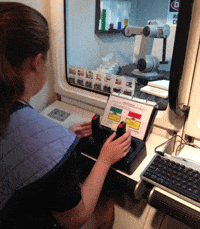
Guiding a robot for chemical experiments
I also got to see how Peter runs the video conference “Astronauts; Living the Dream” was presented to kids. This session incorporates green screen technology to show astronaut food, the shuttle launch site and launch, training requirements, microgravity, space toilets and beds, health needs, and training in the neutral buoyancy lab in Houston. The students are sent freeze dried astronaut food to try either during or after conference plus Peter demonstrated burning a real space shuttle tile with a Bunsen burner. On the more unusual side of video conferences is that run when the presenter is underwater with SCUBA gear. The center runs 2 of these VC programs; one on underwater geometry and the other on buoyancy. As per their other programs the sessions are interactive, requiring students to do simple activities in their classroom whilst communicating with the diver in the pool.
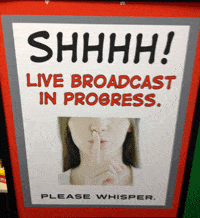
Next up was a session with the Bathysphere Underwater Biological Laboratory, whereby students must complete a series of investigations to investigate the health of the lake through experiments all linked together in a story tracing the uses of Lake Ontario and how students can protect its environment. A variety of STEM components are covered: density, buoyancy, invertebrates, mass spectrometry, archaeology, robotics & CAD, food webs, digital microscopy, filtration, understanding MSDS, navigation and more. Again the students are split into 2 groups to complete their tasks and communicate via video conference between the rooms throughout. A great touch was the addition of the simulators which incorporate diving into the lake and then subsequently resurfacing back to dry land at the end of the 2 hour session. Again, the students were thoroughly engaged and the center was highly immersive (pun intended!).
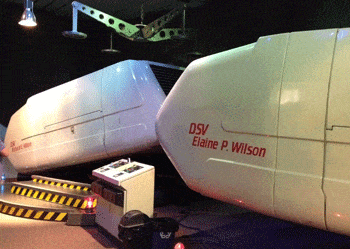
Dive simulators for BUBL
Of course, I couldn’t pass up the chance to visit the Rochester Museum and Science Center nearby. I enjoyed the hands-on physics exhibits such as the tennis ball launcher and vortex makers plus I appreciated the section on American history on the upper level. Rochester was definitely worth the diversion within this tour – next I travel to Washington DC to visit a swath of museum and cultural sites. I very much appreciate the opportunity that the Winston Churchill Memorial Trust has given me and recommend that you look further into what it is all about.
Happy teaching,
























Comments